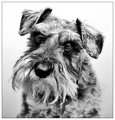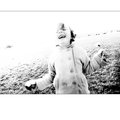| Author | Thread |
|
|
11/18/2009 12:52:46 PM · #1 |
This is a super amateur question, but...oh well! How do you create the "high key" look such as:  or or . .
Is this a camera setup, or is it done in photoshop?
Message edited by author 2009-11-18 12:53:52. |
|
|
|
11/18/2009 01:03:39 PM · #2 |
Essentially, you up your key light (main light)
But the one on the right is just over exposed, and the dog, I don't know if I'd really call that high key. |
|
|
|
11/18/2009 02:13:01 PM · #3 |
| ah...i should have known that. Hmmm I'll play around with it. Thanks. |
|
|
|
11/18/2009 02:21:51 PM · #4 |
| Personally, my take on high key is very little detail remains, but thats questionable. |
|
|
|
11/18/2009 03:17:34 PM · #5 |
When you've got a wide range of light levels (bright lights to dark darks), expose for the darker end. Let the brighter end of the spectrum blow out. Know that your whites are going to blow out and give them purpose in your photo. Don't just have a big blown out white sky unless it somehow compliments the whole photo. In  timfythetoo's and timfythetoo's and  elsapo's photos you used as examples the white sky/background blends across the image into the dark opposite end making a nice balanced gradient. elsapo's photos you used as examples the white sky/background blends across the image into the dark opposite end making a nice balanced gradient.
I entered a high-key into the Foliage challenge. I was trying to use the blown out sky in the center of the photo as a destination to a bright and peaceful place. At the same time since it's essentially blank, the viewer is allowed to fill in for themselves what that destination is. When my boyfriend first saw the photo he thought of Sesame Street, which is where the title came from. I agreed that somehow it reminded me of my childhood and the bright unknown ahead.
 |
|
|
|
11/18/2009 04:19:50 PM · #6 |
In this photo  I used my flash bounced off the ceiling and over exposed slightly. I think AJSullivan is right, my dog photo is not really a good example of high key, it just has a lot of contrast because of the flash intensity and the Black&White processing. I used my flash bounced off the ceiling and over exposed slightly. I think AJSullivan is right, my dog photo is not really a good example of high key, it just has a lot of contrast because of the flash intensity and the Black&White processing.
|
|
|
|
11/18/2009 04:34:14 PM · #7 |
high key photograph is created with careful lighting and correct exposure. It is not created by either overexposure or photoshop.
Hedgecoe is professor of photography at the Royal college of Art. his book. "The Photographers Handbook" is a valuable reference for any photographer
He is a Prolific photographer and author. should be required reading for all photographers
|
|
|
|
11/18/2009 05:12:41 PM · #8 |
This comes to mind...

Message edited by author 2009-11-18 17:12:58. |
|
Home -
Challenges -
Community -
League -
Photos -
Cameras -
Lenses -
Learn -
Help -
Terms of Use -
Privacy -
Top ^
DPChallenge, and website content and design, Copyright © 2001-2025 Challenging Technologies, LLC.
All digital photo copyrights belong to the photographers and may not be used without permission.
Current Server Time: 10/14/2025 06:00:26 PM EDT.

